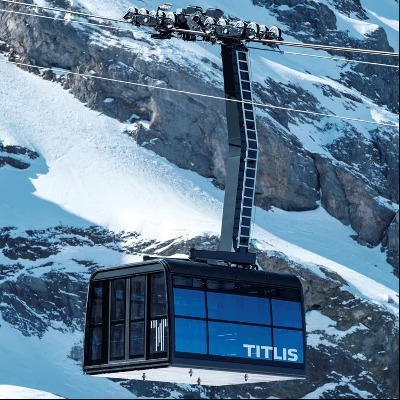Destimetrics - More Smow & Less Covid 19 Equals Slight Improvement For Mountain Destinations; Deficits Still Deep

January brought much-needed snow to many western mountain slopes along with positive news about a drop in both COVID-19 cases and hospitalizations. The combination gave a boost to lodging properties in 18 mountain destinations across eight western states and the mid-winter results were recently distributed by DestiMetrics, the business intelligence division of Inntopia, in their monthly Market Briefing. While properties gained some ground, seasonal deficits remain substantial according to aggregated data regarding occupancy, daily rates, and revenues through Jan. 31.
Booking pace during January
For the first time in three months, DestiMetrics is reporting positive year-over-year gains in the booking pace. Reservations taken in January 2021 for arrival in that same month, are up 42.9 percent compared to January 2020, while bookings for February arrivals based on January-only bookings were up 23.5 percent. March bookings are lagging well behind with a 15.4 percent decrease while the subsequent three months are down dramatically. For the entire six months, bookings made in January for arrivals in January through June are down a modest 5.2 percent compared to last year at this time.
January 2021 results
Actual occupancy for January was down 29.1 percent and the Average Daily Rate (ADR) was down 12.3 percent in a year-over-year comparison. The result was a substantial loss in revenue of 37.8 percent for the month.
Full winter perspective
Occupancy for the full six-month season from November through April is down 27.8 percent compared to last year at this time but marks a moderate improvement from last month—when the season was down 33.1 percent. ADR is down 6.2 percent but is still showing rate gains in three of the six months—November, April, and March. However, the sluggish occupancy when coupled with lower rates is creating a dramatic 32.3 percent decline in winter revenues—but again, an improvement over last month when they were down 36.9 percent.
The Briefing also noted that cancellations are beginning to gradually taper off and have reached their lowest level since the final week of October. The week before Christmas, cancellations accounted for 30 percent of all transactions at participating properties, but by the third week of January they had drifted down to 18.2 of all transactions and for the final week of January, it was only 14.5 percent of all transactions.
“It was encouraging to see that with the arrival of snow in many regions, cautious optimism about the rollout of the vaccine, and declining COVID-19 cases, occupancy clawed back some lost ground during the month,” observed Tom Foley, senior vice president for Business Operations and Analytics for Inntopia. “We are also seeing that consumers remain very focused on short-lead reservations. Bookings made 1-30 days in advance are the predominant transaction, and through some strategic rate management, many properties are achieving some incremental fill.”
Economic measurements
Market news and the day-to-day realities for many Americans continue on contradictory paths. The Dow Jones Industrial Average (DJIA) dipped 1.4 percent during January for the first decline since October. Despite the drop, the Dow Jones is 3.9 percent higher than it was last January. The Consumer Confidence Index (CCI) rose a slight 2.5 percent in January to 89.3 points after slipping in November and December. Consumers showed mixed responses based on the Present Situation Index which showed that concern about COVID-19 cases, hospitalizations, and deaths were tempered by some optimism for improved economic conditions going forward. The national Unemployment Rate dropped from 6.7 percent in December to 6.3 percent in January but the decrease was primarily driven by frustrated job seekers abandoning their job search. An anemic 49,000 new jobs were added during January, substantially below the anticipated 105,000.
“Wall Street continues to remain consistently out of touch with the consumer marketplace and seems to be immune to the long-term concerns surrounding employment and consumer spending,” said Foley. “However, consumers with investments in the financial markets through IRA’s or 401(k) accounts are likely to be buoyed by the stability and growth in their retirement accounts and that may explain why consumer confidence, though well below an acceptable level, has remained higher than expectations through both the pandemic and political volatility of the past year.”
Looking ahead to summer
As of Jan. 31, on-the-books occupancy is down 30.9 percent compared to last summer at this same time and is showing declines in all three months (May-July) that data is available. In sharp contrast, the ADR is up 18.9 percent for those months. However, revenues are down 17.6 percent as the higher rates are not enough to offset the much lower occupancy.
“The improvement in occupancy during January, along with some promising growth in February and March fueled by the short-lead booking trend, has helped move the needle in the right direction and raise hopes for some continued modest recovery,” Foley continued. “However, there is really no way to sugarcoat current conditions as the large deficits in both seasonal occupancy and revenues appear insurmountable at this time. But cancellations are declining while booking volume remains high, and the overall trend is moving upward. So, if the number of COVID-19 cases continues to fall, vaccinations continue to rise, and ample snow arrives, there is optimism that visitors will continue to book a mountain vacation.”













